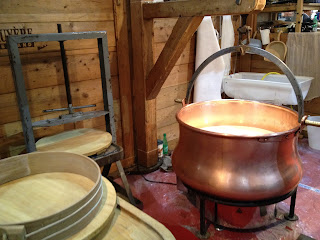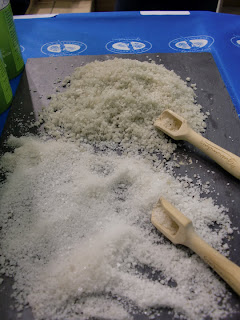 |
| Valentine, The Poster Girl of the Salon |
 |
Olive Oil Producers of Balagne, Corisca
|
The Paris Salon de L'Agriculture, first held in 1870, is the largest agricultural exhibition in the world and is held annually at the end of February. In fact, the French call it, "
la plus grande ferme du monde" which means " the largest farm in the world." All the regions of France are represented, showcasing their local foodways and cultural traditions. Pavilion upon pavilion, alley upon alley, the salon is an endless and dizzying display of foraging, cultivating, growing, raising, harvesting, curing, preserving, and cooking from each of France's regions and is the celebration of the bounty of their unique and diverse terroirs.
|
Aging Comté Cheese 4 to 24 months |
Comté has been produced in the former "free country" of Burgundy since the 12th century when shepherds would spend the summer months with their Montbeliard Cattle in the rugged Jura Mountains, feeding them on the luscious tender grasses and alpine flowers. Since the grazing lands were so far from the towns, the shepherds would pool their milk to make huge wheels that would take months to mature and therefore could be stored in their remote huts until the end of the season when they were carried to market. The 110 pound wheels take up to 160 gallons of milk.
 |
| Making Comté Cheese From Franche-Comté |
Fresh from the cow, milk is poured into large copper vats where it is gently warmed. Rennet is added causing the milk to coagulate. The curds are then cut into tiny white grains that are the size of rice or wheat which are then stirred before being heated again for around 30 minutes. The contents are then placed into moulds and the whey is pressed out.
After several hours the mould is opened and left to mature in cellars.
 |
| Guérande Sea Salt From Southern Brittany |
Meet Pierre Pereon: The Descendant of a long line of salt workers "Paludiers" from the Guérande salt marshes. Pierre wasn't intending to follow the family career, but his love of the environment brought him back to the marshes. As he says: " I chose this job first and foremost as a means of perserving and bringing life to a site that I know is very special." Sea Salt is obtained the same way today as it was in antiquity- natural solar-evaporation. When exposed to sun and wind, seawater evaporates, and course salt crystals remain. The salt is hand-harvested using the salt workers' unique, ancestral skills and hand tools passed down through the generations going back to the Celtics and Vikings.
 |
| Naturally Course Sea Salt & The Flower Of Salt |
The Guérande salt marshes are in Southern Brittany between the mouths of the rivers Loire and Vilaine, on the
Atlantic Ocean. They form a very large wetland zone in western Loire-Atlantique and are sustainable and protected ecological wetlands preserved through the unique cultural heritage of saltworks. A natural, authentic, and traditional product, sea salt is not only cleaner and better for you than processed table salt, it imparts greater flavor to the ingredients you season it with because of the natural occuring minerals, lack of additives, and the courseness of the actual crystals of salt.








No comments:
Post a Comment
Note: Only a member of this blog may post a comment.